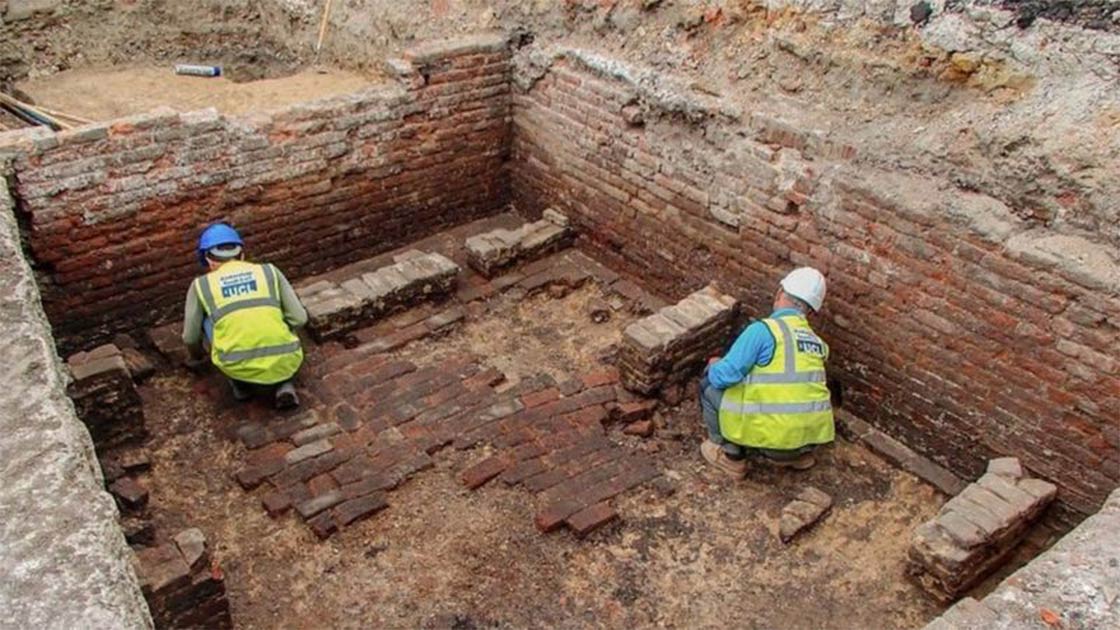London’s Oldest Theater Unearthed in Whitechapel
Archaeologists in London have made an amazing discovery. They have unearthed what they believe to be London’s oldest theater, the Elizabethan Red Lion. This structure is of immense importance because it was a model for later playhouses of the Elizabethan era. This was the period that produced some of the greatest English-language dramatists, including William Shakespeare and Christopher Marlowe.
The discovery was made by archaeologists from Archaeology Southeast, in the Whitechapel area of East London. They found the site in 2019, but it took them a year to be confident that they had found the famed Red Lion. According to the Independent, “the Red Lion was a drinking establishment, which in 1567, allowed London’s first purpose-built theater to be constructed on its property.”
The site was found underneath a self-storage facility, and one of the striking discoveries was the well-preserved brick-lined cellar. Stephen White, the lead archaeologist, is quoted by The Guardian as saying that “this is one of the most extraordinary sites I’ve worked on.”
Archaeologists Identify London Playhouse Thanks to Historic Legal Documents
The Guardian states that the exact location of the London theater has “been the subject of conjecture and debate for a number of years.” Archaeologists were able to identify the historic playhouse thanks to descriptions in legal documents detailing a bitter dispute between the owner and the carpenters who built the Red Lion.

Based on their investigations, Archaeologists from Archaeology South-East have produced a map of what the site may have looked like. (Archaeology South-East / UCL)
These documents describe the timber galleries that surrounded the stage and its dimensions. The archaeologists were stunned when they began to realize that their site was revealing evidence of a multi-story auditorium, and its similarities to the description in the court documents. White told the BBC that evidence seems to “match up with characteristics of the playhouse recorded in early documents.”
The theater was located outside the municipal boundaries of the city of London in the 1560s. At the time playhouses were controversial locations, deeply suspected by the Protestant puritans who believed theater to be an ungodly endeavor which encouraged political discontent.
The Red Lion was established by John Brayne. Brayne later established another theater in Shoreditch, where many of Shakespeare’s plays were premiered. The Red Lion establishment was originally a farm with an inn, before Brayne came up with the idea to convert it to a playhouse. There was an open-air theater outside the inn.
London’s Oldest Theater Represents Missing Link in the History of English Drama
It appears that traveling actors would stage dramas in the playhouse. Due to the Red Lion’s popularity, Brayne decided to build another, larger, playhouse in Shoreditch in London, which became the first permanent home for traveling troupes of actors. This initially fared well until Brayne went bankrupt and died in poverty. It is believed that the Red Lion Theater was abandoned in the 1590s as more playhouses were built in London, including the famous Globe Theater.
The Independent reports that the theater “represents a major ‘missing link’ in the history of English drama.” The first dramas produced here were religious plays, such as the long-lost Story of Samson, an extravaganza based on the Biblical hero. Soon, however, secular plays were being performed at the playhouse. This was an important change which paved the way for dramatic geniuses, such as Shakespeare, to revolutionize theater.
- Archaeology Is Revealing New Clues About Shakespeare’s Life
- Hiding to Avoid Hanging: Priest Holes, Hidden Chambers, and Secret Passages
- Fifty Ancient Skeletons Found Crammed Together under Westminster Abbey Toilet Block
Dogfighting in the Age of Shakespeare
The archaeologists found a great number of artifacts related to drinking. This should come as no surprise, as The Red Lion was also an inn and there was a great deal of alcohol consumed during Elizabethan dramatic performances. They also found many fragments from green ceramic money boxes. Theatergoers would place their fee into these boxes and the proprietor would later break them open to retrieve the money. According to the Independent, this “simple ‘cash and smash’ system helped prevent staff pilfering any of the coins.”

Archaeologists found a 17th century tavern mug at the Whitechapel dig site which bears a medallion of Charles II. (Archaeology South-East / UCL)
The playhouse was repurposed after the theater was closed in the 1590s. Archaeologists found a great many dog bones with traces of injury and have concluded that they are the remains of fighting dogs. Fighting specially bred dogs was a popular blood sport, along with bearbaiting, in Elizabethan England. The Independent reports that “an analysis of the dogs’ jaws shows that some of their more lethal teeth had been filed down, probably in order to prolong the fights.” By filing their teeth down, it took longer for the dogs to kill each other.

Archaeologists have discovered what they believe to be the long-lost Red Lion Theater, uncovering a rectangular timber structure with 144 surviving timbers. (Archaeology South-East / UCL)
Recent Discoveries Shed Light on the History of English Theater
The discovery of The Red Lion is helping researchers to better understand the origins of Elizabethan drama. According to the BBC, “Emily Gee, from Historic England, said the latest discovery was ‘tantalizing’.”
Work at the site is ongoing, in collaboration with the owner of the property. The probable re-discovery of the playhouse is only the latest in a series of similar discoveries. In recent years, the remains of the Boar’s Head and The Curtain playhouses have been uncovered in London.
Top image: Archaeologists found the remains of well-preserved brick-lined cellar believed to be of London’s oldest theater, the Red Lion playhouse, in Whitechapel, East London. Source: Archaeology South-East / UCL
By Ed Whelan

















